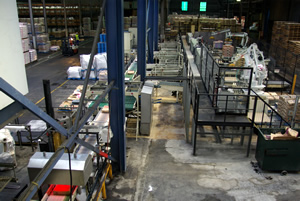Vision tackles a sweet challenge at NZ Sugar
New Zealand Sugar, Chelsea Sugar Refinery
Auckland, New Zealand
- Vision-based ID reading replaces traditional bar code readers for improved read rates
- Pattern Matching identifies problem products with confusing graphics
- Data and image logging allows on going improvement




The iconic Chelsea sugar refinery in Auckland recently solved a long standing problem with their manufacturing process using Machine Vision.
In 2000 Chelsea introduced a flexible palletizing approach in their manufacturing process. The output of all 10 production lines pass down a single high-speed transport conveyor to a palletizing and packaging area. Products are identified on the transport conveyor and automatically routed to one of 5 robotic palletizing workcells.
With up to 50 types of product ranging in bag material, decoration graphics, size and weight, the one Achilles heal of this design has been reliable identification of product. Any products that can't be identified require manual packing.
The conventional barcode scanners used where not able to achieve the high read-rates required by this application, and with up to 1200 products per hour, NZ Sugar had one or two line operators busily hand-stacking sugar bags. The solution: a 2Mpx Cognex In-Sight vision sensor with ID reading and advanced pattern matching capabilities.
The In-Sight reads barcodes off the sugar packs in any position or orientation. Because a camera looks at the entire code it is more tolerant and able to read damaged or partially creased codes. On some problem products, where codes are regularly creased beyond readability, pattern match is used to identify the product using taught unique features in the artwork.
Any read-failures can be analysed offline using images captured by the camera allowing problem products to be identified, artwork improvements made and then improvements monitored.
The overall result is a major productivity improvement - with identification approaching 100%.